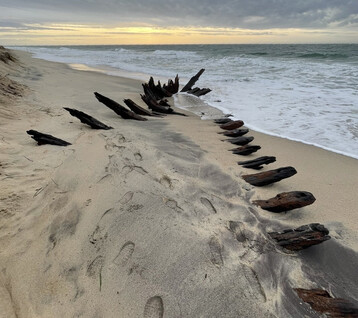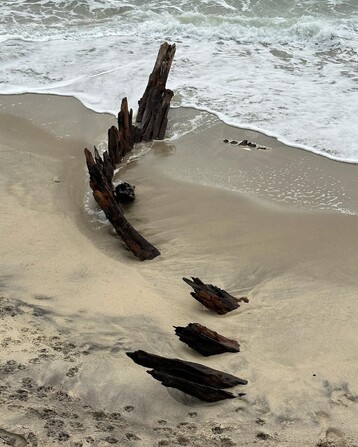South Shore Shipwreck Believed To Be The 19th Century Schooner Warren Sawyer
Jason Graziadei •

The shipwreck discovered on Nantucket’s south shore in December is believed to be a portion of the 19th century coastal schooner Warren Sawyer, a wooden ship that wrecked near Miacomet Beach on December 22, 1884, according to the findings of state archeologist David Robinson.
Robinson, the director and chief archeologist for the Massachusetts Board of Underwater Archeological Resources (BUAR), visited the island to inspect the shipwreck just days after it was discovered, and has spent the past two months researching it with Nantucket officials from the Egan Maritime Institute and the Nantucket Historical Association.
“As with most historical archaeological research, exploring the available literature, archival, photographic, and archaeological evidence we collectively assembled for the site to try to arrive at a conclusive determination as to whether or not the wreckage is from the tern, Warren Sawyer, was a bit like pulling a thread on a sweater,” Robinson said. “The more interesting information I looked at, the more that I found.”
Robinson determined that the shipwreck is likely to be a relatively small section of the Warren Sawyer’s hull from its lower bow. But in a statement released with the Egan Maritime Institute Thursday morning, the researchers cautioned that they could not claim with “complete certainty” that the wreck was the Warren Sawyer noting an inconsistency in the type of fastening hardware recorded for the ship, and the fact that there had also been other wrecks along the south shore in roughly the same area.
But if in fact the south shore shipwreck is indeed the remains of the Warren Sawyer, it represents a remarkable, tangible example of Nantucket’s maritime history.

“Her unfortunate end on the island's south shore in 1884 is one of Nantucket's most complete and remarkable stories of shoals, storms, and rescue,” said Charles Allard, director of Egan Maritime’s Shipwreck and Lifesaving Museum, about the Warren Sawyer. “The Surfside Life-Saving Station saved the crew, wreckers salvaged most of the cargo, the shipwreck site has been known to reveal itself about every 20 years.”
According to the Nantucket Historical Association, “Captain Edwin L. Saunders and his seven men were rescued within an hour by the crew of the Surfside Lifesaving Station, despite the schooner rolling violently in the surf. Over the next two weeks, before the wreck broke up, islanders worked to discharge the vessel’s cargo and salvage its equipment and spars, while the curious turned out to take in the dramatic scene. Artist Wendell Macy, always looking for subject matter that would sell, painted at least seven versions of this scene. He exhibited this one (below) at Congdon’s Pharmacy on Main Street and later shipped it to New Bedford for exhibition. The Inquirer and Mirror praised it as one of the artist’s ‘finest efforts in marine work, in which he has been so successful heretofore’.”

The research on the shipwreck began on Thursday, Dec. 8, when Robinson, along with Graham McKay, a BUAR Board member and marine archaeologist, visited the island and met with Egan Maritime’s education director Evan Schwanfelder, as well as chief curator at the Nantucket Historical Association, Michael Harrison, and the town of Nantucket’s preservation planner, Holly Backus. The group surveyed the site and began the archiving process.
“David and Graham, from the Mass Board of Underwater Archeology, are an incredible resource for our island,” Schwanfelder said. “They have an extensive knowledge of the best practices in marine archeology and the history that is hidden just under our feet and under the water.”



